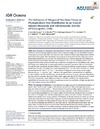Identificador persistente para citar o vincular este elemento:
https://accedacris.ulpgc.es/jspui/handle/10553/73657
| Título: | The Influence of Diapycnal Nutrient Fluxes on Phytoplankton Size Distribution in an Area of Intense Mesoscale and Submesoscale Activity off Concepción, Chile | Autores/as: | Corredor-Acosta, A. Morales, C. E. Rodríguez-Santana, A. Anabalón, V. Valencia, L. P. Hormazabal, S. |
Clasificación UNESCO: | 2510 Oceanografía | Palabras clave: | Coastal Upwelling Front Diapycnal Nutrient Flux Intrathermocline Eddy Phytoplankton Size Structure Thorpe Scale Method, et al. |
Fecha de publicación: | 2020 | Publicación seriada: | Journal of geophysical research. Oceans | Resumen: | Mesoscale and submesoscale processes that contribute to localized increases in nutrients in the sunlit layer can stimulate phytoplankton growth and community changes, but the mechanisms involved remain sparsely documented with in situ data in the case of Eastern Boundary Upwelling Systems (EBUSs) and of most ocean regions. The role of diapycnal mixing in providing nutrients to the upper layer and in influencing phytoplankton size structure was analyzed in an area of intense mesoscale and submesoscale activity during the coastal upwelling season off Concepción (~36–37°S), the Humboldt Current EBUS. Diapycnal nutrient fluxes based on conductivity, temperature, and depth vertical eddy diffusivity (Kz) values (the Thorpe scale method) and on nutrient gradients were assessed in association with size-fractionated chlorophyll-a and microdiatom abundance derived from in situ sampling in an area including a mesoscale intrathermocline eddy (ITE) adjacent to a coastal upwelling front (CUF). The indirect estimates of Kz values spanned between 0.01 and 4 × 10−4 m2 s−1, and maxima in diapycnal nitrate flux per station ranged between 0.08 and 19.1 mmol m−2 day−1. Maxima in the upward fluxes were detected at the subsurface (15–40 m depth) in the CUF and ITE areas, coinciding with maxima in the micro- and nano-chlorophyll-a fractions and in microdiatom abundance. These results suggest that ITE and CUF features, as well as their interaction, can generate intense diapycnal mixing and, thereby, contribute to increasing nutrient availability below the mixed layer. In turn, these processes enhance the contribution of larger phytoplankton cells in the coastal transition zone of EBUSs. | URI: | https://accedacris.ulpgc.es/handle/10553/73657 | ISSN: | 2169-9275 | DOI: | 10.1029/2019JC015539 | Fuente: | Journal of Geophysical Research: Oceans [ISSN 2169-9275], v. 125 (5), e2019JC015539 (Mayo 2020) |
| Colección: | Artículos |
Citas SCOPUSTM
6
actualizado el 08-jun-2025
Citas de WEB OF SCIENCETM
Citations
7
actualizado el 08-jun-2025
Visitas
71
actualizado el 11-ene-2026
Descargas
87
actualizado el 11-ene-2026
Google ScholarTM
Verifica
Altmetric
Comparte
Exporta metadatos
Los elementos en ULPGC accedaCRIS están protegidos por derechos de autor con todos los derechos reservados, a menos que se indique lo contrario.
